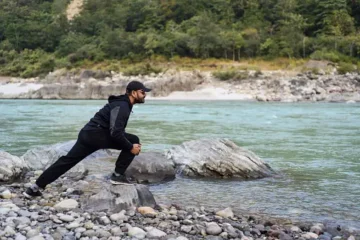In the high-flying, gravity-defying world of trampoline gymnastics, it’s possible to follow fashion trends while staying safe and performing at your best. Dressing appropriately is essential, but that doesn’t mean you have to sacrifice style. Just as you wouldn’t wear pyjamas to a wedding or a suit to bed, it’s important to choose the right attire for trampoline gymnastics that reflects your personal style while offering the flexibility, comfort, and safety you need.
This sport isn’t just about looking good—it’s about feeling confident and secure in what you wear. The wrong clothing can turn an exhilarating routine into a frustrating or risky experience. Fortunately, trampoline gymnastics demands specific attire designed to move with you, so you can express your fashion sense without compromising on performance.
In this guide, we’re diving into everything you need to know about dressing fashionably and functionally for trampoline gymnastics. From stylish leotards to trendy yet practical footwear—or going barefoot—we’ll cover it all. By the end of this read, you’ll be fully equipped to hit the trampoline with attire that not only enhances your performance but also keeps you on-trend, letting you focus on what really matters: nailing that next routine with style and confidence.
Essential Trampoline Gymnastics Attire
The right attire ensures you’re not only comfortable but also safe as you flip, twist, and soar on the 14ft trampoline. Let’s break down the essentials.
Leotards
Leotards are the go-to choice for most trampoline gymnasts, and for good reason. They’re designed to move with your body, offering a snug fit that stays in place no matter how high you bounce or how complex your routine gets. Unlike loose clothing that can shift or get caught, a leotard remains secure, allowing you to focus entirely on your performance.
Benefits of Wearing a Leotard
- Freedom of Movement: Leotards are typically made from stretchy, breathable materials like spandex or Lycra, which offer excellent flexibility. This means your leotard moves with you, allowing a full range of motion for every twist, turn, and jump.
- Stays in Place: One of the biggest advantages of leotards is their ability to stay put. During flips and jumps on the best 12ft trampoline, the last thing you want is to worry about your clothing shifting or exposing too much skin. A well-fitted leotard eliminates this concern, giving you one less thing to think about mid-air.
- Enhanced Aerodynamics: The sleek design of a leotard minimises drag, which can make a difference in a sport where precision and speed are key.
Tips for Choosing the Right Leotard
- Fit: Your leotard should fit like a second skin—snug but not restrictive. Make sure there’s no pinching at the seams or sagging in the fabric. A well-fitted leotard will feel comfortable and allow you to move freely.
- Material: Look for high-quality, breathable materials like spandex or Lycra. These fabrics offer both stretch and durability, which are crucial for handling the rigours of 10ft trampoline gymnastics.
- Style: While aesthetics are secondary to functionality, choosing a style that you feel confident in can boost your performance. Whether you prefer sleeveless, long-sleeved, or something in between, make sure it’s something you’re comfortable wearing during intense routines.
Unitards and Alternative Options
If you prefer more coverage than a traditional leotard offers, unitards are an excellent alternative. A unitard extends down to your legs, providing the same secure fit as a leotard but with added coverage. This can be particularly appealing during colder months or for those who simply feel more comfortable with a bit more fabric.
Benefits of Unitards
- Full-Body Coverage: Unitards offer full-body coverage, which can be more comfortable for some athletes, especially during rigorous training sessions.
- Secure Fit: Like leotards, unitards are designed to stay in place, ensuring that you’re covered no matter how intense your routine becomes.
Alternative Athletic Wear
- Compression Shorts and Tops: For those who prefer to mix and match, form-fitting athletic wear such as compression shorts paired with a fitted top can be a good alternative. These pieces should be made from similar materials as leotards—stretchy, breathable, and moisture-wicking—to provide comfort and flexibility.
- Considerations: When choosing alternative athletic wear, ensure that your shorts aren’t too loose or long, as they could interfere with your movements. The top should also be form-fitting to avoid any riding up or shifting during your routine.
In trampoline gymnastics, every detail counts, and your attire is no exception. By choosing the right leotard, unitard, or athletic wear, you’re setting yourself up for success, allowing you to focus on your form and technique without any distractions.
Footwear: To Wear or Not to Wear?
Deciding what to wear on your feet for fitness trampoline gymnastics is more important than you might think. Whether you choose to go barefoot, wear specialised trampoline shoes, or opt for grip socks, each choice impacts your performance and safety. Let’s explore the options.
Why Many Trampoline Gymnasts Prefer Barefoot
Going barefoot on the trampoline is a popular choice among gymnasts and for good reason. When you’re barefoot, you have direct contact with the in-ground trampoline surface, giving you better control and tactile feedback. This means you can feel the trampoline beneath your feet, allowing you to adjust your balance and positioning more naturally during jumps, flips, and landings.
Benefits of Jumping Barefoot
- Better Control: Without any barriers between your feet and the trampoline, you can sense the mat’s texture and tension more precisely. This enhances your ability to make micro-adjustments during your routine, leading to smoother transitions and more controlled movements.
- Tactile Feedback: Bare feet provide immediate feedback from the trampoline, helping you gauge your bounce and adjust your technique in real time. This can be especially beneficial when learning new skills or refining existing ones.
- Enhanced Balance: The natural grip of your bare feet can improve your balance, giving you more confidence during complex manoeuvres.
Trampoline Shoes or Socks
While barefoot is often preferred, some gymnasts opt for specialised trampoline shoes or grip socks, which can offer certain advantages. However, it’s important to note that traditional shoes are generally not recommended for rectangle trampoline gymnastics, as they can damage the trampoline material and may not provide the necessary flexibility and feel.
Why Grip Socks Are a Better Option
- Enhanced Grip with Flexibility: Grip socks offer the best of both worlds—they provide improved traction while still allowing your feet to move naturally. The grips on the bottom of the socks prevent slipping, which can be especially helpful during fast-paced routines.
- Protection Without Bulk: Unlike shoes, grip socks are lightweight and won’t add bulk or restrict your movement, making them a safer and more comfortable option for trampoline gymnastics.
- Trampoline-Friendly: Grip socks are designed with the trampoline’s surface in mind. They won’t damage the material, ensuring that your equipment remains in good condition.
When to Choose Grip Socks
- Cold Weather: If you’re training in a cooler environment, grip socks can keep your feet warm without sacrificing performance.
- Competitions or Performances: Some gymnasts prefer the security of grip socks during competitions or performances, where every movement counts, and the stakes are higher.
In trampoline gymnastics, your choice of footwear—or lack thereof—can make a significant difference in how you perform.
Practical Tips for Buying Trampoline Gymnastics Gear
When purchasing outdoor trampoline gymnastics gear, informed decisions are key to getting the best value without compromising quality. Here are some tips to guide you:
Shopping Recommendations
- Specialty Gymnastics Stores: Brands like GK Elite, Destira, and Alpha Factor offer high-quality, sport-specific attire.
- Online Retailers: Amazon and Etsy provide a wide variety of options, including customizable leotards and accessories.
- Brand Websites: Buy directly from brands to ensure authenticity and access exclusive designs.
- Local Sporting Goods Stores: Stores like Dick’s Sporting Goods offer basic, high-quality gear that you can try before buying.
Budget-Friendly Options
- Off-Season Sales: Shop during off-seasons for discounts.
- Bundle Deals: Look for deals that include multiple items at a reduced rate.
- Discount Retailers: Stores like TJ Maxx and Marshalls offer brand-name athletic wear at lower prices.
- Online Marketplaces: Sites like eBay and Poshmark offer gently used gear at a fraction of the cost.
Second-Hand Gear
- Pros: Cost-effective, eco-friendly, and unique finds.
- Cons: Potential wear and tear, sizing issues, and limited return policies.
- Where to Buy: Check eBay, Poshmark, local thrift stores, and gymnastics community sales.
Why the Right Gear Matters
Choosing the right trampoline gear is essential for enhancing performance. Proper attire ensures comfort, safety, and confidence, allowing you to focus on perfecting your routine.
Conclusion
Choosing the right attire for trampoline gymnastics is more than just a matter of style—it’s about enhancing your performance and keeping yourself safe. When you feel comfortable and confident in what you’re wearing, you can focus entirely on your routine, knowing your gear won’t let you down. The right leotard, grip socks, or even second-hand finds can make a world of difference as you soar through the air.
It’s also important to consider any specific dress codes or safety guidelines set by your gym or coach. Adhering to these not only ensures your safety but also shows your commitment to the sport. Every detail, from the fabric of your leotard to the choice between barefoot and grip socks, plays a role in your performance.
We all know how much better it feels to train when everything is just right—from the fit of your gear to the way it moves with you. So, take the time to find what works best for you. And if you have any tips or experiences to share, we’d love to hear them. After all, the best advice often comes from those who live and breathe the sport!
Keep an eye for more news & updates on Discover Tribune!




